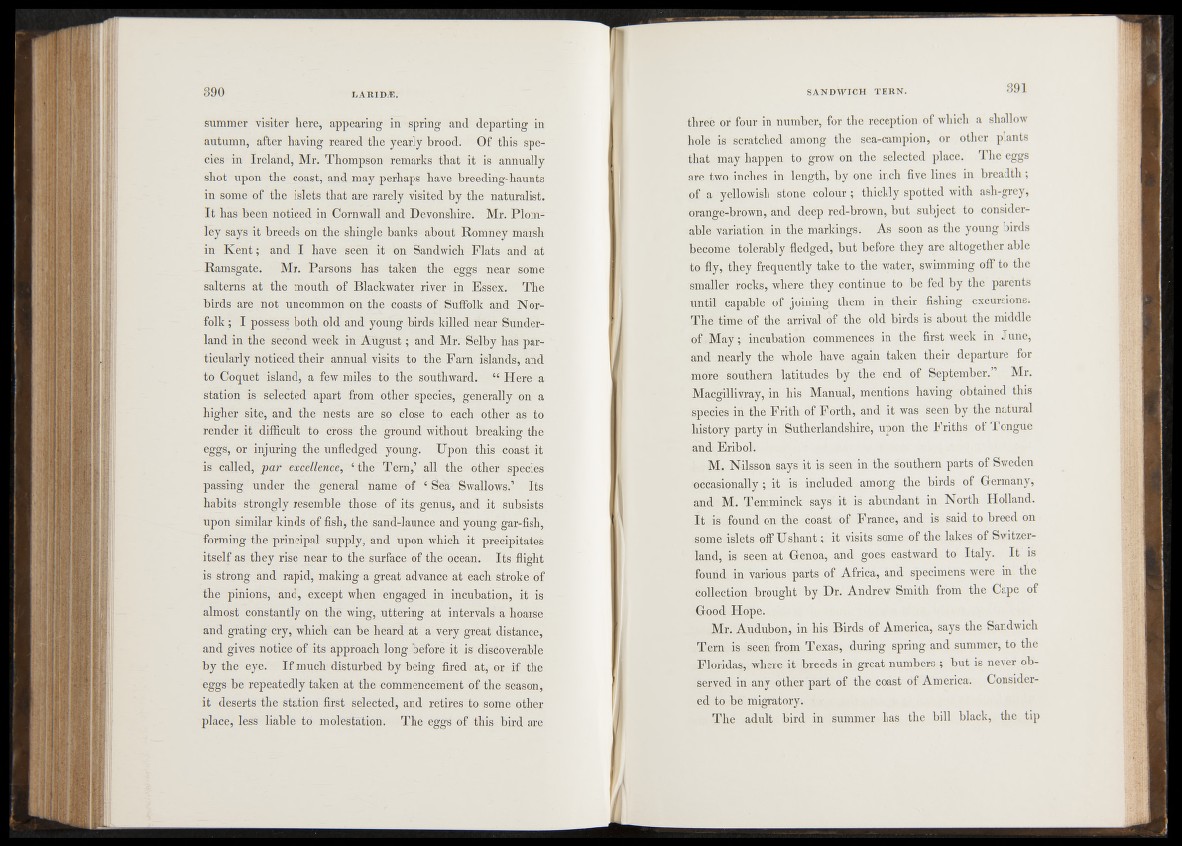
summer visiter here, appearing in spring and departing in
autumn, after having reared the yearly brood. Of this species
in Ireland, Mr. Thompson remarks that it is annually
shot upon the coast, and may perhaps have breeding-haunts
in some of the islets that are rarely visited by the naturalist.
I t has been noticed in Cornwall and Devonshire. Mr. PlomF
ley says-it breeds on the shingle banks ^bout Romney marsh
in K ent; and I have seen it on Sandwich Flats and 'at
-Ramsgate. Mr. Parsons has taken the eggs near some
salterns at the mputh of Blackwater rivdpln Essex. The
birds are not uncommon on the coasts, of Suffolk and Norfolk
; I -possess both old and young birds killed Sear Sunderland
in the second week in August; and Mr. Selby has particularly
noticed their annual visits to the Fam islands, and
to Coquet island, a few miles .to the southward. HHere a
station is selected apart from other species, generally on a
higher site, and the nests are ..so close'’to- each other as to
render it difficult to cross the ground without breaking the
eggs, or injuring the unfledged, young. Upon this coast it
is called, par excellence, ‘ the Tern,’ all the other species
passing under the general name of 4 ijsfeh- Swallows,1 T|p
habits • strongly resemble those of its genus, and it subsists
upon similar kinds of fishy the sandJaunce and young gar-fish,
forming the principal supply, and upon which-it precipitate!
itself as they rise near to the surface of the ocean. Its flight
is strong and rapid, making a great advance at each stroke of
the pinions, and, except when engaged in incubation, it is
almost constantly on the wing, .uttering at intervals a hoarse
and grating cry, which can be heard at a. very great distance,
and gives notice of its approach long before it is discoverable
by the eye. I f much disturbed by being fired- at, or if the
eggs be repeatedly taken at the commencement of the season,
it deserts the station first selected, and retires to some other
place, less liable to molestation. The eggs of-this bird are
three or four in number, for the reception of which a shallow
hole is scratched among the sea-campion, or other plants
that may happen to grow on the selected place. The eggs
are two inches in length, by one inch five lines in breadth;
of a yellowish stone colour; thickly spotted with ash-grey,
orange-brown, and deep red-brown, but subject to considerable
variatidfi in the markings. As soon as the young birds
become tolerably fledged, but before they are altogether able
to fly, they frequently take to-the water, swimming off to the
smaller locks, where they continue to be fed by the parents
until %pabi|s of joining them in their fishing excursions.
The time of the arrival df the old birds is about the middle
o f ; May ;•■ incubation- commences in the first week in June,
and nearly the whole have again taken their departure for
more. southern latitudes by the end of September.” Mr.
Macgillivray, in his Manual, mentions having obtained this
Species in the Frith of Forth, and it was seen by the natural
history party in Sutherlandshire, upon the Friths of Tongue
and Eriboll-
' :M. Nilsson says it is seen in the southern parts of Sweden
occasionally ; it is included among the birds of Germany,
and M. Temminck says’ it is abundant in North Holland.
I t . is found on the coast of France, and is said to breed on
some Islets off Ushant; it visits some of the lakes of Switzerland,
is seen at Genoa, and goes eastward to Italy. I t is
found in various parts of Africa, and specimens were in the
^collection brought by Dr. Andrew Smith from the Cape of
Good Hope.
Mr. Audubon, in his Birds of America, says the Sandwich
Tern is seen from Texas, during spring and summer, to the
Floridas; where it breeds in great numbers ; but is never observed
in any other part of the coast of America. Considered
to be migratory. '
The adult bird in summer has the bill black, the tip